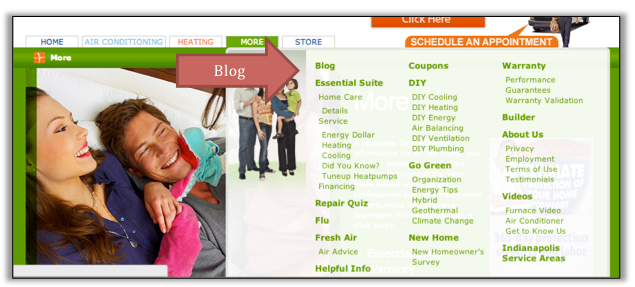Wasp Barcode Technologies: The Barcode Solution People
The Small Business Secret of Not Being Ignored – part 5
 Sean Jackson
Copyblogger
Sean Jackson
Copyblogger |
We have finally come to the last post in the series! The first post covered what components make up a successful SMB website and the remaining posts dove deeper into how one could go about implementing components such as, content, SEO, back-linking, aesthetics and, finally, a blog. |
The theory that most people are familiar with is the hub and spokes. If a businesses’ blog is the hub, than the spokes are the social media platforms used to promote the blog. It is often that case that blogs are another way companies can encourage customers to convert. By providing information, how-to’s, guides and troubleshooting tips, a company is increasing customer loyalty by proving they care more about the customer’s problem than selling their product, and the company can also create a community awareness certifying they are an expert in their industry. And by using the spokes (social media platforms) companies are reaching a larger audience and directing that audience back to the blog.
There are several alternatives when incorporating a blog into your website. And let’s just say for argument sake that your business wants to use its blog as part of its marketing strategy. There are a few things to decide: do you want a blog that acts as both a resource for your products and a center for industry news and updates, do you want two separate landing pages to use as an information spot, or do you just want to utilize one or the other?
The first example I’m going to show you is a business who incorporates both a resource center and a blog.
 The solid arrow points to the landing page in which we are viewing: “Learn”, while the “Blog” arrow points to where a user can choose to read REI’s blog. REI does a great job of using its “Learning” landing page as its resource center, offering users a place to read about tips, tricks, to learn from guides, to watch videos and become educated about general outdoor preparedness and activities. The blog acts as a news source for industry topics and a forum for discussion. Both landing pages encourage customer loyalty and increase the overall image of industry expert, while also allowing users the opportunity to buy products (increasing conversion).
The solid arrow points to the landing page in which we are viewing: “Learn”, while the “Blog” arrow points to where a user can choose to read REI’s blog. REI does a great job of using its “Learning” landing page as its resource center, offering users a place to read about tips, tricks, to learn from guides, to watch videos and become educated about general outdoor preparedness and activities. The blog acts as a news source for industry topics and a forum for discussion. Both landing pages encourage customer loyalty and increase the overall image of industry expert, while also allowing users the opportunity to buy products (increasing conversion).
Some companies choose to use their blog as both a resource center and actual blog. Take Slingshot SEO’s blog for example. It acts as an industry news hub spot, a center for how-to’s, guides and tutorials while also incorporating videos, infographics and images in order to give its readers the best opportunity to learn from an expert, find answers and purchase its services, if needed.

The other option is to choose to implement either a blog or a resource center. This division often occurs for businesses in the service field. For example, an HVAC company may choose to use a blog (which really acts as a resource center) to direct customers towards tips, tricks, troubleshooting methods and more. However, it is becoming more common for businesses to incorporate both as it really provides users needed information while building brand loyalty.
So after you’ve added a blog/resource center you might be asking, “What should I talk about?” If you provide a service you could write guides on how users can troubleshoot a product, tips on how users can test and see if they need a service provider, tricks for customers on how to keep their product running smoothly, other uses for your product, etc.
 Above is an example of Airtron Indy’s resource center. They also offer the option of a blog indicated at the very top. The sub categories are guides, tip and other information for users to use when they’re searching for answers.
Above is an example of Airtron Indy’s resource center. They also offer the option of a blog indicated at the very top. The sub categories are guides, tip and other information for users to use when they’re searching for answers.
Another trick I like to apply when brainstorming blog topics is going to
Yahoo! answers, typing in a keyword and seeing what questions have been asked surrounding that topic. Not only does this give you an idea of what people want to learn, if gives you the opportunity to answer a question that may not be addressed. Or, if others in the community have answered the question now’s the time for you to join the conversation.
Another approach would be to locate your competitors, whom you can find by using
Google’s AdPlanner, and see what conversations they’ve immersed themselves in. This is a chance for you to incorporate your hub and spokes method. Follow the industry news, and employ competitor analysis to see what hot topics are being discussed. Air your comments via social media platforms and link back to well-known news source, or your own website (if you’ve written about the topic – which you should have!).
 Above is a piece of the AdPlanner’s analysis for the website Mashable.com. Try typing in your company’s website to see related searches. Or, you can try good ole fashioned search and just type in “”Your company’s name here” competitors.”
Above is a piece of the AdPlanner’s analysis for the website Mashable.com. Try typing in your company’s website to see related searches. Or, you can try good ole fashioned search and just type in “”Your company’s name here” competitors.”
For more blog content ideas, try re-using old posts that created a lot of stir or increased engagement. See if you can add to the post, re-vamp it or bring new light to a comment or question posed by a reader. And of course, stay tuned in your industry news and follow experts who share blogging tips, like
Kissmetrics, for example.
I hope you found this series helpful. Please let me know if you have questions about specific tactics, or components I mentioned. I would love to hear what strategies you employ to make your SMB website successful!







